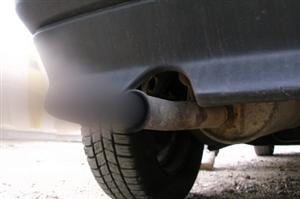| Complexity level: | 7 |
| Project cost ($): | 50 |
| Time required: | 4 hours to prepare, 1 day to conduct this science fair project |
| Material availability: | You will need to obtain 4 cars of the same make and model, but of varying ages |
| Safety concerns: | Carbon monoxide gas is extremely poisonous. Use a gas safety mask and ensure the presence of adult supervision when performing measurements. |
Hypothesis
The new car will emit the smallest amount of carbon monoxide, while the 20-year-old car will have the highest emissions.
Overview
Carbon monoxide
The combustion engine of a car is one of the biggest contributors of air pollution, due to the steadily increasing worldwide car population. The combustion of fuel and air in the car engine releases hydrocarbons, carbon dioxide, carbon monoxide and nitrogen oxide into the atmosphere.
Carbon monoxide consists of a single carbon and oxygen molecule (CO). It does not have any color or odor, but is a poisonous gas and a product of fuel that is not completely burned. During engine startups, the mix ratio between air and fuel is very low. This results in a lack of oxygen for the combustion to take place and higher carbon monoxide emissions. Carbon monoxide emissions are also higher in cars that are poorly tuned, and are used at higher altitudes.
In human beings, carbon monoxide affects the ability of blood cells to carry oxygen. This is because carbon monoxide is attracted to the hemoglobin in our blood and prevents it from supplying oxygen to the cells. When the carbon monoxide levels in the bloodstream becomes too high, symptoms of nausea, dizziness, flu and headaches start to appear. Higher levels of carbon monoxide can cause brain damage and death.
Scientific Terms
Materials
The materials required for this experiment:
- A new car
- A 5-year-old car
- A 10-year-old car
- A 20-year-old car
- Cars of the same make and model are required
- A carbon monoxide detector
- An industrial fan
- 2 safety masks
Procedure
1. For this experiment, the independent variable is the age and the location of the car. The dependent variable is the amount of carbon monoxide released by the car, which will be determined with the carbon monoxide detector. The constants (control variables) are the make and model of the car, the time the car engine is allowed to run and the size of the garage.
2. Park the new car inside a closed garage. Wear the safety mask securely to prevent the inhalation of poisonous gasses. Place the carbon monoxide detector 20cm away from the car exhaust pipe. With help from an adult, start the car engine and leave it running for 20 minutes. Take the reading of the carbon monoxide level from the detector and record it in a table, as shown below. Open the garage door and leave the industrial fan running until the air inside the garage is replaced with fresh air.
3. Drive the car out of the garage. Again, place the carbon monoxide detector 20cm away from the exhaust pipe. Start the car engine and leave it running for 20 minutes. Then, take the reading of the carbon monoxide level from the detector and record it in a table, as shown below.
4. Repeat steps 2 and 3 using the 5-year-old, 10-year-old and 20-year-old cars. Record all readings in a table, as shown below

Results
The results show that the 20-year-old car has the highest carbon monoxide emission levels while the new car produces the least carbon monoxide. The carbon monoxide levels were higher in the closed garage and lower in the open space.
| Test location | Age of car and carbon monoxide emission measured in parts per million (ppm) | |||
| New | 5 years | 10 years | 20 years | |
| Closed garage | 18 | 21 | 112 | 337 |
| Open space | 6 | 9 | 38 | 146 |
The chart below represents the results of our science fair project

Conclusion
The hypothesis that a new car will have the lowest amount of carbon monoxide emissions and that the 20-year-old car will have the highest emission levels has been proven to be true.
Among the sources of carbon monoxide are cars left running in enclosed spaces, as well as open fires, water heaters or blocked chimneys. Inhaling high levels of carbon monoxide is harmful and can even cause death. Installation of carbon monoxide detectors in homes is highly recommended to prevent carbon monoxide poisoning.
Also consider
The experiment may be repeated in different locations, such as an underground car park or a congested road with heavy traffic.
The experiment can also be done to measure the release of other gasses like hydrocarbons, nitrogen oxides or carbon dioxide.
Also, you might want to consider trying to determine if there is a clear correlation between the size of the car's engine and the level of emission of carbon monoxide.
References
Car exhaust – air pollutants - http://www.nutramed.com/environment/carsepa.htm
Carbon monoxide - http://www.extension.iastate.edu/pages/communications/co/co1.html
Carbon monoxide detector - http://en.wikipedia.org/wiki/Carbon_monoxide_detector

